The water in the pressure pipes for heating and water supply always flows in the same direction. If, for some reason, it suddenly moves through the pipes in the opposite direction, the system stops working as usual. Simply put, a water supply failure occurs with all the ensuing consequences. To prevent such failures in the circuits, a check valve is used - a simple device that lets water through in only one direction. For those who are going to install a pipeline in a country house, apartment or in the country with their own hands, the editorial staff of the site "bestx.htgetrid.com/en/" offers a review "The best check valves for water for 2020", compiled according to the opinion of buyers and experts.
Content
What is a check valve for?
Our life is unthinkable without water supply, heating, ventilation and sewerage systems.
All of the above systems perform specific functions:
- delivery of drinking water to the places of its analysis;
- circulation of the coolant of water heating;
- air circulation in forced ventilation boxes;
- natural gas supply to gas consuming equipment: stove, water heater, heating boiler;
- disposal of waste products (sewage).
To obtain the maximum effect, engineering systems are equipped with control and accounting elements:
- shut-off and control valves: ball valves and valves, mixers and valves;
- pumps;
- filters;
- meters for technical and commercial accounting of energy environments.
All of them are designed to create and maintain the conditions necessary for its functioning in the energy system: pressure, temperature, circulation (in water heating), consumption (amount of consumed energy carrier in liters, cubic meters, calories). One of the most important conditions for the uninterrupted functioning of engineering networks is to ensure the movement of the energy carrier in one given direction. A check valve fulfills this task.
It passes water or gas in one direction and automatically closes when the working medium in the pipe stops or rushes in the opposite direction.
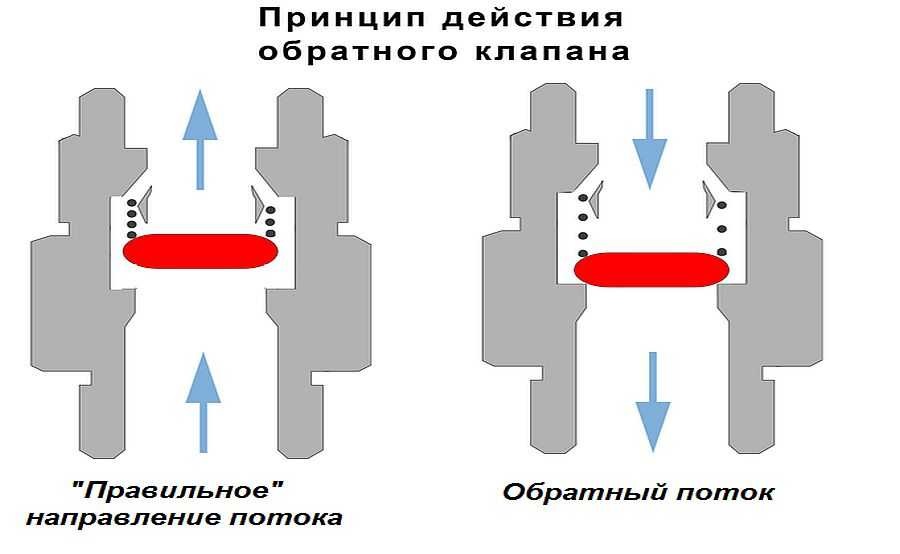
Let us consider several scenarios for the development of events in which the installation of this device is necessary.
Pressure change in heating systems
The main condition for the effective operation of water heating is the constant movement of the coolant in a circle (contour) or circulation.
Important! Water heating is a closed circuit in which the working pressure and circulation of the heat carrier is created and constantly maintained by a pump. If the system is working properly, the delivery head will always be higher than in the "return".
When the pump stops in case of a breakdown or due to a power outage, the pressure drops to zero, and the water begins to cool down, since it heats up only with constant circulation through the water heater (heat exchanger or boiler).In addition, when the pump is stopped, the water from the upper point of the heating circuit is drained downward by gravity. The released volume will immediately be filled with air, which is easily compressed when the pump is started, making it impossible to quickly restore the pressure.
To prevent such effects, check valves are used in the construction of pumping stations of closed circuits of heating or cooling of technological equipment.
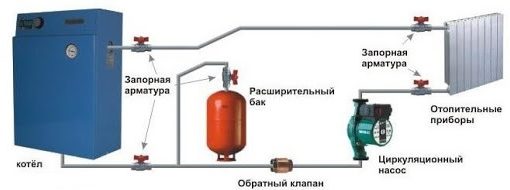
On a note! In closed circuits, check valves are mounted on the discharge side of the pump. The arrow on the body must point towards the pressure head.
While the pump is running, the shut-off element will always be open. When the pump is stopped, it will close, preventing the coolant from draining from the supply. Consequently, during the second start, such unpleasant phenomena as water hammer or air leaks will not occur, which will have to be removed for a long time to resume circulation.
Make-up check valves
In closed heating or process circuits with a large volume of circulating water, it is difficult to avoid small leaks through stuffing box seals or loose connections of shut-off valves. In such cases, in order to prevent filling the circuit with air and emergency shutdown of the equipment, a system for feeding it with treated (purified) water is provided. To avoid mixing of circulating and make-up water, a shut-off valve is mounted on the tie-in in a closed circuit, which automatically opens only towards the return circuit.
Water-air systems
In some cases, process pipes are periodically purged with compressed air. In metallurgy, water-air cooling of red-hot ingots is often used, when water and air are fed through separate pipes to a nozzle. In both, compressed air is cut into the water supply lines. In order not to mix various media in the pipes, cut-off devices are mounted on the tie-ins.
Water transfer in water supply systems
Often there is the effect of squeezing hot water into a cold riser or vice versa. This situation is especially common for those who have installed a hygienic shower in the apartment bathroom. The device itself is not much different from an ordinary bath mixer, only without a gander. The same lever valve with a cartridge and a flexible hose with a handle and a splitter that breaks the stream. Some manufacturers equip this handle with a button or a lever that, when pressed, will bring water to the divider.
Imagine a situation where the user forgot to close the main lever valve. Until no one pulls the trigger on the handle, water will not flow from the divider, and the hygienic shower can stay in this position for a long time. An old lever valve cartridge may lose density and two streams with different temperatures will begin to mix. Hot water, having a higher pressure, will gradually fill the cold riser. After some time, boiling water will flow from all the neighbors, "sitting" on the same riser, from the "cold" faucet taps, or vice versa, then everyone will have to wash with cold water. To prevent the effect of squeezing, it is enough to mount cut-off devices on the outlet side of valves or ball valves in the tie-in into the risers.
Important! In this case, the arrows on the body should be directed towards your water-folding devices.
Borehole pump check valve
Country houses and summer cottages are most often supplied with water from wells by pumping it with a submersible pump through a pipe into a storage tank. The top point in this case is the accumulator, the bottom is the bottom of the well. The submersible pump is only switched on to fill the storage tank and does not run continuously. During the periods of its stops, the water from the reservoir will go back into the well. To prevent this from happening, the product of interest to us is mounted in front of the pump.
Important! In this case, the directional arrow must point towards the pump.
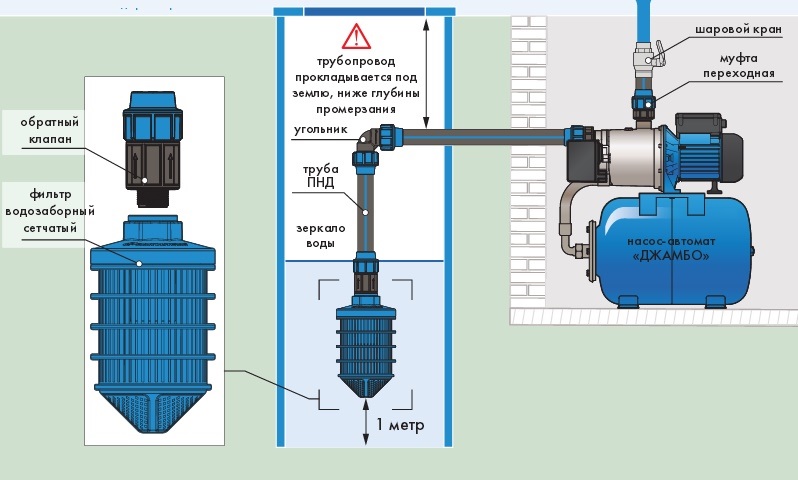
Check valves on the sewer
It is difficult to imagine a situation in which a check valve is required on a gravity sewer. In the absence of pressure, water will not flow upward. But if the user has installed a dishwasher in his kitchen, then on this unit the manufacturer has already installed a cut-off on the drain hose from the car to the apartment sewer. This will protect expensive equipment from filling with dirty water if suddenly the apartment sewage system stops passing waste water (gets clogged).
Device and principle of operation
Before starting the selection of automatic shut-off devices, you should find out in more detail what they are, how they differ from each other, what materials they are made of. A product of any type consists of almost the same set of basic elements.
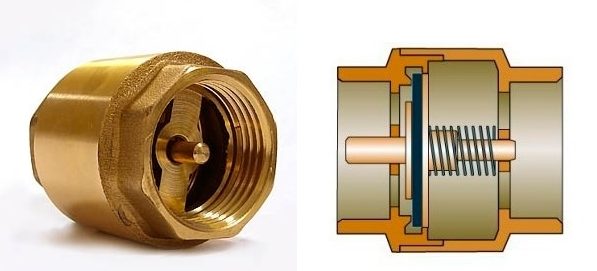
Housing
Can be made of corrosion-resistant materials: brass, stainless steel, cast iron or polypropylene. An arrow is applied to the surface, indicating the direction of movement of the medium, the pressure for which it is calculated, in megapascals (MPa), and the diameter in inches or millimeters.
Shut-off organ
It can be in the form of a ball, disk, plate. In some models, the shut-off body is made in the form of flaps, like a disc cut in half. Above the cut line and parallel to it, an axis is mounted on which the leaf springs are put.
Spring
Keeps the shut-off element in the "closed" position in the absence of pressure. When the pump is turned on, the shut-off element compresses the spring and opens the passage, passing to the "open" position.
Seal
The valve seat is sealed with a polymer material to ensure a tight seal and tightness in the closed position. PTFE is most often chosen as the material for the seal, in other words, fluoroplastic.
Despite some differences, products of all types have a common principle of operation:
- water enters the apparatus and presses on the shut-off element;
- the spring pressing the shut-off element to the seat is compressed;
- the shut-off body, moving behind the compressing spring, is torn off from the seat, freeing the passage in the desired direction;
- when the pressure of water decreases, the spring expands and presses on the shut-off element, pressing it against the seat, closing the passage.
Thus, any possibility of changing the direction of movement of water in the pipeline is excluded.
What are the valves
Taking into account the design features, the following types of devices are distinguished:
- lifting;
- petal;
- bivalve;
- gravitational.
It makes sense to get to know each of them better.
Gravity valves
Most devices can be classified as spring-loaded. The exception is the gravity valves, the mechanism of which does without springs. Their shut-off organ is also opened by the pressure of water. In the absence of pressure, it returns to its place under the influence of its own weight (gravity). Their construction is extremely simple. The disc of the shut-off body is suspended at one end on an axis fixed in the body. Under the pressure of water, the disc rotates on an axis and rises with its free edge upward, opening the way for water. In the absence of influence, the disc, under its own weight, returns to the saddle, closing the water passage.
The gravitational ones include the petal (pictured below) and the rarely used ball valve. In the first case, the origin of the name can be explained by the similarity of the locking organ with the petal. In the second, the passage of water closes and opens a hollow ball made of lightweight corrosion-resistant materials.
Spring loaded valves
This type includes all similar products, except for gravitational ones.
Lifting
The locking mechanism of such devices is a metal disc sliding along a plastic rod passed through a hole in its center. The ends of the stem pass through the holes of the spool plates, preventing axial displacement. A spring is installed between the shut-off element and one of the spool plates. When water is supplied to the device inlet, the valve disc rises, compressing the spring. Hence its name - lifting.
Bivalve
The shut-off element in such devices consists of two halves of the disc, fixed on a steel axis, on which, moreover, springs are put on, holding the flaps in the "closed" position. By water pressure, the flaps open to let water through.
Interesting! In the "open" position, the flaps resemble wings. Hence its popular name - butterfly.
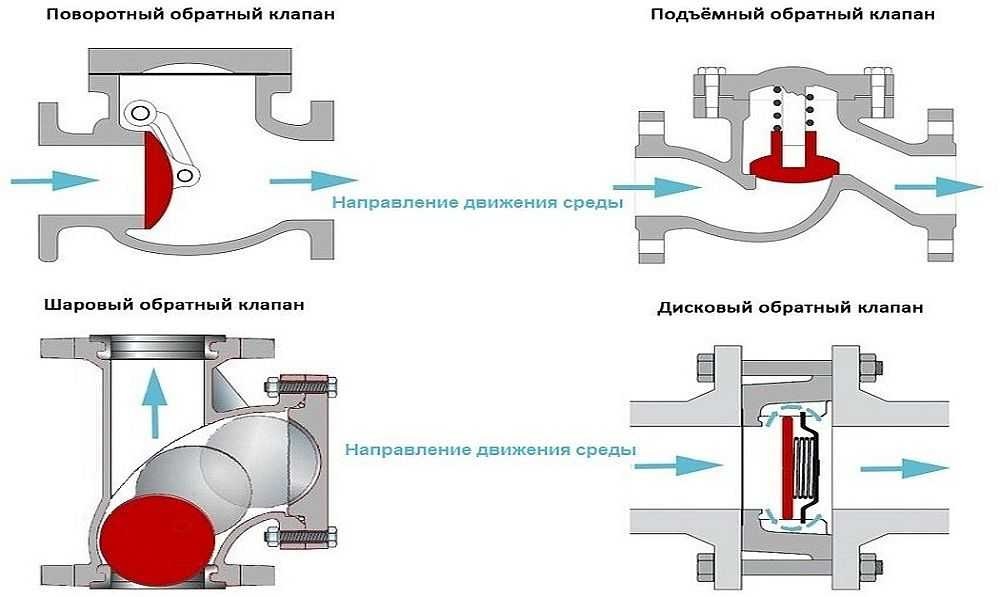
How to choose a check valve
A similar device is selected for the pipeline, i.e. it is necessary to take into account the parameters of an existing circuit or one that still exist in the project. From this point of view, we will consider the criteria for choosing the most suitable device.
Diameter and connection method
Let's start with the designations found in the diagrams, accompanying documentation and on the bodies of shut-off and control valves. The diameters of pipes and all equipment included in the scheme are measured in millimeters and inches. The pipe has two diameters:
- internal, denoted by Du - nominal diameter;
- outer.
In heating and water supply schemes for apartments and country houses, the concept of Du is used with a gradation of 15, 20, 25, 32, 40 and 50 mm. A foreign manufacturer measures the diameter of its products in inches. Our 15 mm corresponds to the designation 1/2 “. Then follow the inch designations corresponding to "our" millimeters: 3/4 ", 1", 1 ¼ ‘’, 1.5 ‘’, 2 ’’. Larger pipe diameters for intra-apartment schemes are practically not used.
If you need to protect your hot and cold water meters, look for products marked DN 15 or 1/2 “. If in doubt, consider the diameter designations on the already installed shut-off valves (ball valve or valve) in front of the meter and choose a product with the same marking.
By way of joining
In this sense, sanitary ware is:
- Coupling. It is connected to pipes on a thread, with the obligatory sealing of the counter thread with an FUM tape, a tangit unilok thread or a linen strand.
- Flanged. Bolted connection of pipes with fittings through paronite or rubber gaskets. To ensure tightness, tighten the nuts on the flange bolts crosswise, ie. tightening the first bolt, tighten the next one that is diagonally opposite to it.
- Wafer. In this case, the valve has neither flanges nor threads. It is clamped with bolts or studs between the pipeline flanges. Wafer fittings are often supplied with gaskets already installed on them.
- Welded. It is connected to the pipeline by welding.
Intra-apartment circuits are most often assembled on a thread. In country houses, with heating from their own boiler, it is possible to use flange connections. When choosing a product, the connection method must be taken into account.
Body material
This part is made from cast iron, stainless steel, brass and plastic. Cast iron is heavy and shatters easily upon impact. Stainless steel is a material for centuries, but expensive. Plastic is good, but not always. It is not recommended for use in heating circuits, since plastic fittings work best with polypropylene pipes, which do not tolerate high water temperatures well. The best option in almost all cases (except for plastic and sewage) will be a brass body.
Choice of valve design
A win-win option would be a spring device. It will always provide sufficient tightness in any spatial position. Gravity devices work flawlessly on a horizontal section of the pipeline. A vertically mounted unit may not close without a spring.
On a note! If you are offered to purchase a horizontal valve, know that you are dealing with a gravity device.
Lifting devices work well in any spatial position and differ from others for the better in that they are suitable for repair without dismantling. It is enough to remove the upper case cover to eliminate the malfunction and return it to work.
Bivalves work well as part of technological pipelines.The minimum diameter of such a product is not less than two inches and is rarely used for apartment wiring.
What to look for
Be sure to evaluate the petal material, presence and seal material as applied to the characteristics of your circuit: pressure and maximum temperature. Ask yourself how important it is to you that the device is as tight as possible. For example, if you are looking for fittings for a heating system, leaks are unacceptable, and the seal material must withstand temperatures of about 130 ° C.
It's another matter if you need to pump water from the well into a storage tank in the country with a submersible pump, but you don't want to take the pump out of the well. A spring-type apparatus with a plastic petal can be put on the hose. If it passes a few dozen drops of water per minute, this is not a problem.
If you have steam heating, you will have to choose fittings without O-rings and collars, since it is difficult to find a sealing material that can withstand the temperature of hot steam for a long time. This type of seal is called metal-to-metal. The saddle and the surface of the petal in such devices rub against each other tightly enough to ensure the necessary tightness.
In any case, it will not be superfluous to listen to the advice and recommendations of specialists, carefully study the installation instructions, description and characteristics of the product. This will allow you not to make mistakes when choosing a decent model.
Top manufacturers
The question always arises: which company is the best product to buy. Of course, you need to choose products from manufacturers who have proven themselves in the production of high quality products and preferably at an affordable price. You should get to know the best manufacturers.
Stout
European brand with production in Germany, Spain, Italy, Russia. The products are ISO certified, manufactured using innovative technologies, using modern equipment and sold at an affordable price.
Sobim
Spain, Barcelona. It manufactures products from brass of its own production. The production is organized on the basis of the ISO quality management system and has the appropriate certificates. Popular brand models are in constant demand from specialists.
Kalde
Turkish company. It is one of the leading manufacturers of polypropylene fittings and sanitary fittings in the world. The popularity of the brand's models is based on the high quality of its products and the increased demand for polypropylene pipelines in the last decade.
CTM
The products of the Chinese brand are of good quality and budget price. On the domestic market since 2006. They have only positive user reviews.
Gilex
Russian company. The main activity is pumping equipment, fittings and control valves. High-quality and inexpensive products are in demand among specialists.
ITAP
High quality brass products made in Italy. There is nothing more to add.
Danfoss
An international company of Danish origin, whose products are world famous. The main directions: industrial automation, heat engineering, refrigeration units. Devices of the brand are in high demand among installers of industrial pipeline communications. For home use, this is quite an expensive pleasure.
Ari armaturen
A German brand, popular with industrial installers, just like Danfoss products. The main activity is the production of high quality control valves.
Herz
International company headquartered in Vienna. The world's leading manufacturer of fittings and fittings for heating, water supply and refrigeration systems.
Genebre
High quality shut-off and control valves from Spain.
Where can I buy
Better in a specialty store. In this case, the product can be seen and touched by hands, evaluate the appearance, assembly and check the device for operation without water. You can order online the desired product in the online store.It is easier to use the well-known Internet resource "Yandex Market". Here you can find out how much the required product costs, study its description and characteristics, choose an online store and place an order.
Rating of quality check valves
10. Sobim 1/2 “HP
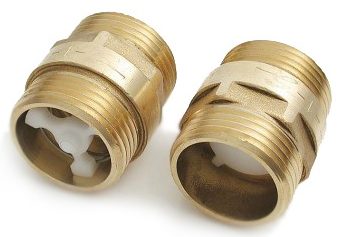
The product from the collection of the Spanish brand is distinguished by its simplicity, small size and light weight. The body is made of brass, the disc is made of plastic. Connection diameter (DN) - half-inch or DN 15mm. Design - spring clutch. Excellent option for installation on a submersible pump hose. The average price is 165 rubles.
Advantages:
- brass body;
- compact size;
- coupling connection;
- inexpensive.
Disadvantages:
- it is not advisable to use a plastic disc in a heating system.
9. Kalde 1 “3222 - cvl - 0c0000 25
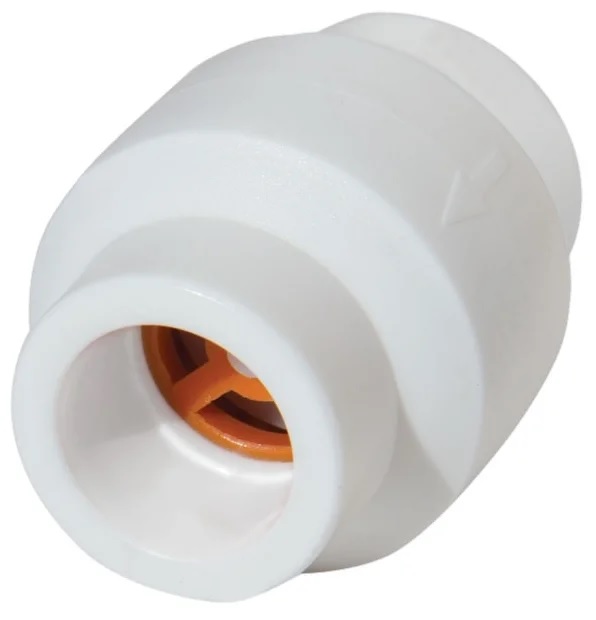
Spring welded shut-off device of Turkish production with a nominal diameter of one inch or 25 mm. The body material is polypropylene. Works flawlessly in cold and hot water supply systems. It is sold at a price of 250 rubles.
Advantages:
- not subject to corrosion;
- failsafe in hot and cold water supply systems;
- affordable price.
Disadvantages:
- do-it-yourself installation requires a special "soldering iron" and some skills in welding polypropylene pipes;
- not intended for use in heating systems.
8. STM CBCV F001 1 “
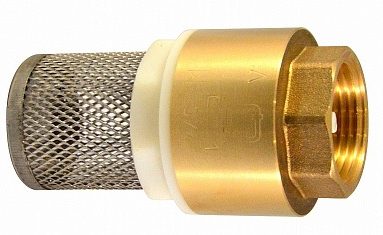
Spring clutch model made in China. Connection diameter - one inch. Designed for use in any pipelines with a working medium temperature up to 100 ° C. The brass body is designed for pressures up to 16 bar (1.6 MPa). A reliable budget option for in-house pipelines. Average price: 224 rubles.
Advantages:
- brass body;
- spring mechanism;
- affordable price.
Disadvantages:
- not identified.
7. Stout 1 “
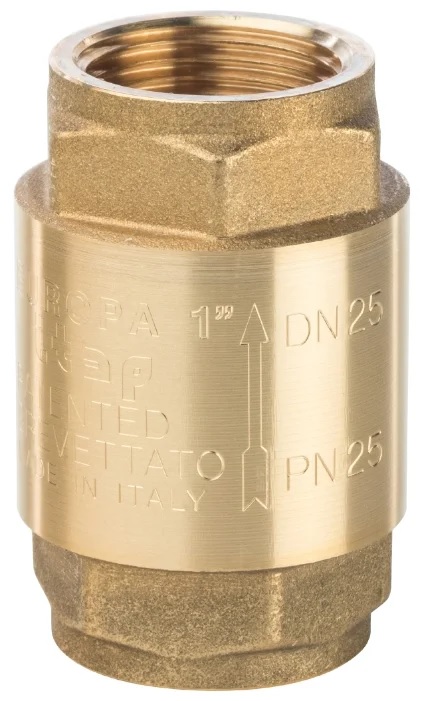
Another spring device in a brass body, with a connecting diameter of 1 “or 25 mm. The manufacturer is the international European company Stout. PN 25 marking on the body informs the buyer that the product can withstand water pressure of 25 bar (2.5 MPa). The method of connection to the pipeline is coupling. It works reliably in heating and water supply systems. It will show itself quite well together with borehole pumps in water supply systems of country houses. Has the best customer reviews and good value for money. Average price: 460 rubles.
Advantages:
- brass body;
- high quality assembly;
- affordable price.
Disadvantages:
- not found.
6. Jilex 1 “
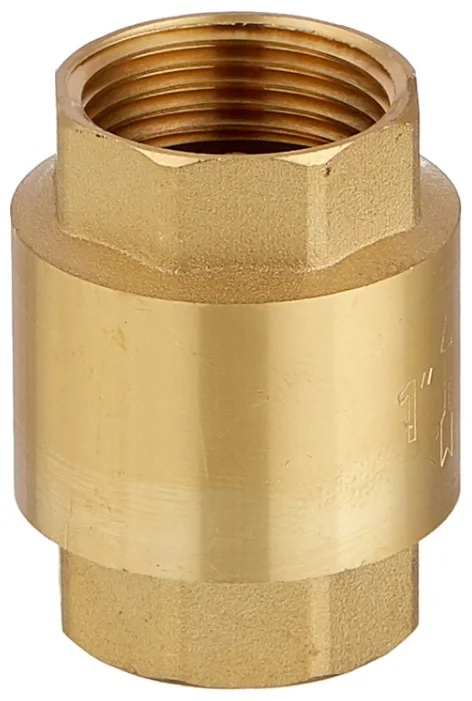
Russian-made product with brass body, stem and spring mechanism. Single-leaf, coupling, with a connecting diameter of one inch (25 mm). A solid product for installation in any pipe system. Average cost: 520 rubles.
Advantages:
- high quality brass body;
- simple and reliable locking mechanism;
- durable brass stem.
Disadvantages:
- high price.
5. Herz 1/2 "
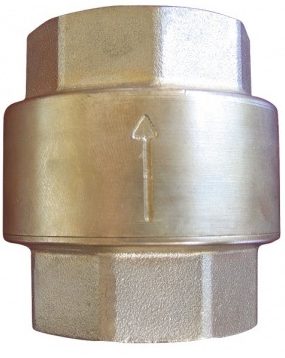
Half-inch device from an international company of Austrian origin. The brass coupling body and spring mechanism make it suitable for the installation of any plumbing systems with pipelines DN 15 mm. It works flawlessly, reliably locking the water, thanks to the NBR seat seal. Withstands pressure of 10 bar (1.0 MPa) and temperature of the working medium up to 95 ° C. Average price: 635 rubles.
Advantages:
- brass body;
- high-quality assembly;
- good tightness.
Disadvantages:
- high price.
4. Itap 1 “
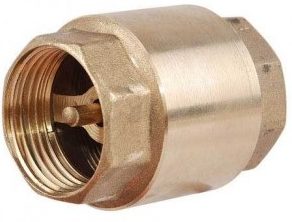
Model from a leading Italian manufacturer. Very solid product with brass body and stem, stainless steel disc and spring, NBR seal. Withstands pressures of 25 bar (2.5 MPa) and water temperatures up to 100 ° C. It can be practically used in pipelines for any purpose. Coupling connection, nominal bore diameter - 1 inch. Average price: 660 rubles.
Advantages:
- high quality material;
- reliable assembly;
- high working pressure and temperature.
Disadvantages:
- not identified.
3. Genebre 1 1/4 "
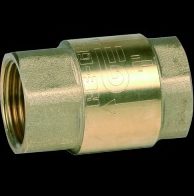
The third place in the review is taken by a product from the Spanish brand "Genebre". Coupling locking device with brass body, spring mechanism and connection diameter 1 1/4 “(32 mm). Designed for operation in any pipeline systems, including gas and air, with a maximum pressure of 25 bar and a medium temperature up to 100 ° C. A minimum pressure of 0.04 bar is sufficient to open the passage. Works flawlessly in any position. Average cost: 735 rubles.
Advantages:
- quality materials;
- reliable assembly;
- versatility.
Disadvantages:
- high price.
2. Itap 103 York 1 1/2 ”
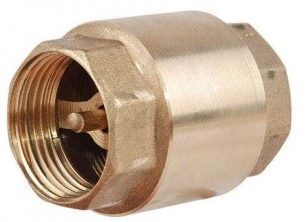
Spring locking device made in Italy. Brass body, one and a half inch (40 mm) socket connection. Designed for trouble-free operation in pipelines with a pressure of 10 bar and a carrier temperature of up to 100 ° C. The average cost is 1098 rubles.
Advantages:
- high quality material;
- excellent build;
- reliable work in any spatial position;
- long-term operation guarantee.
Disadvantages:
- high price.
1. Danfoss 2 "
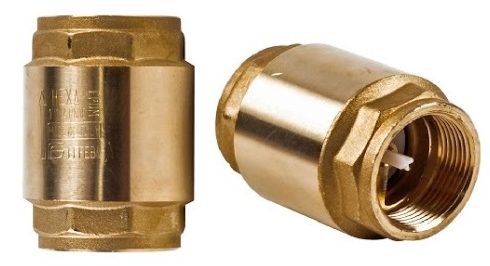
The first place in the rating is occupied by the branded check valve of the world famous Danish manufacturer Danfoss. Brass spring locking device with two inch (50 mm) connection diameter. Able to withstand water pressure of 18 bar and work with non-aggressive liquids with temperatures up to 100 ° C in any position. Average cost: 2117 rubles.
Advantages:
- excellent quality material;
- reliable assembly;
- manufacturer's warranty.
Disadvantages:
- very high price.
A check valve is a small, affordable device that is necessary to organize the trouble-free operation of heating systems and plumbing. The editors of the site hope that our review will help readers find out what it is, how to install it yourself or replace it during repairs, answer all the questions that arise and help you make the right choice.












